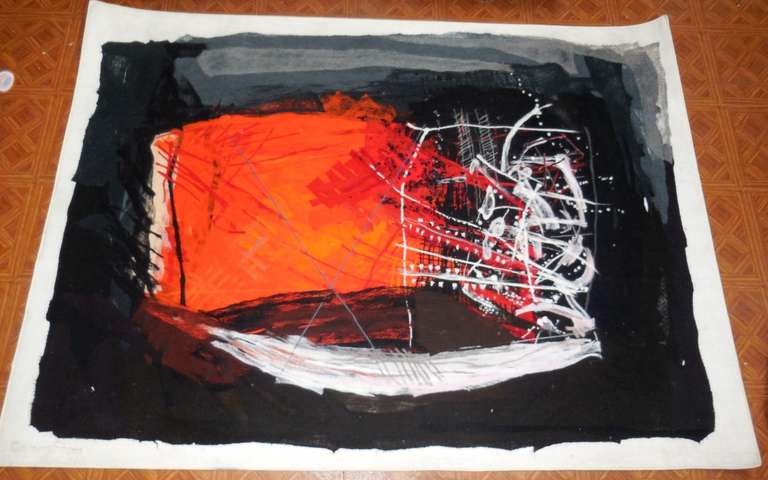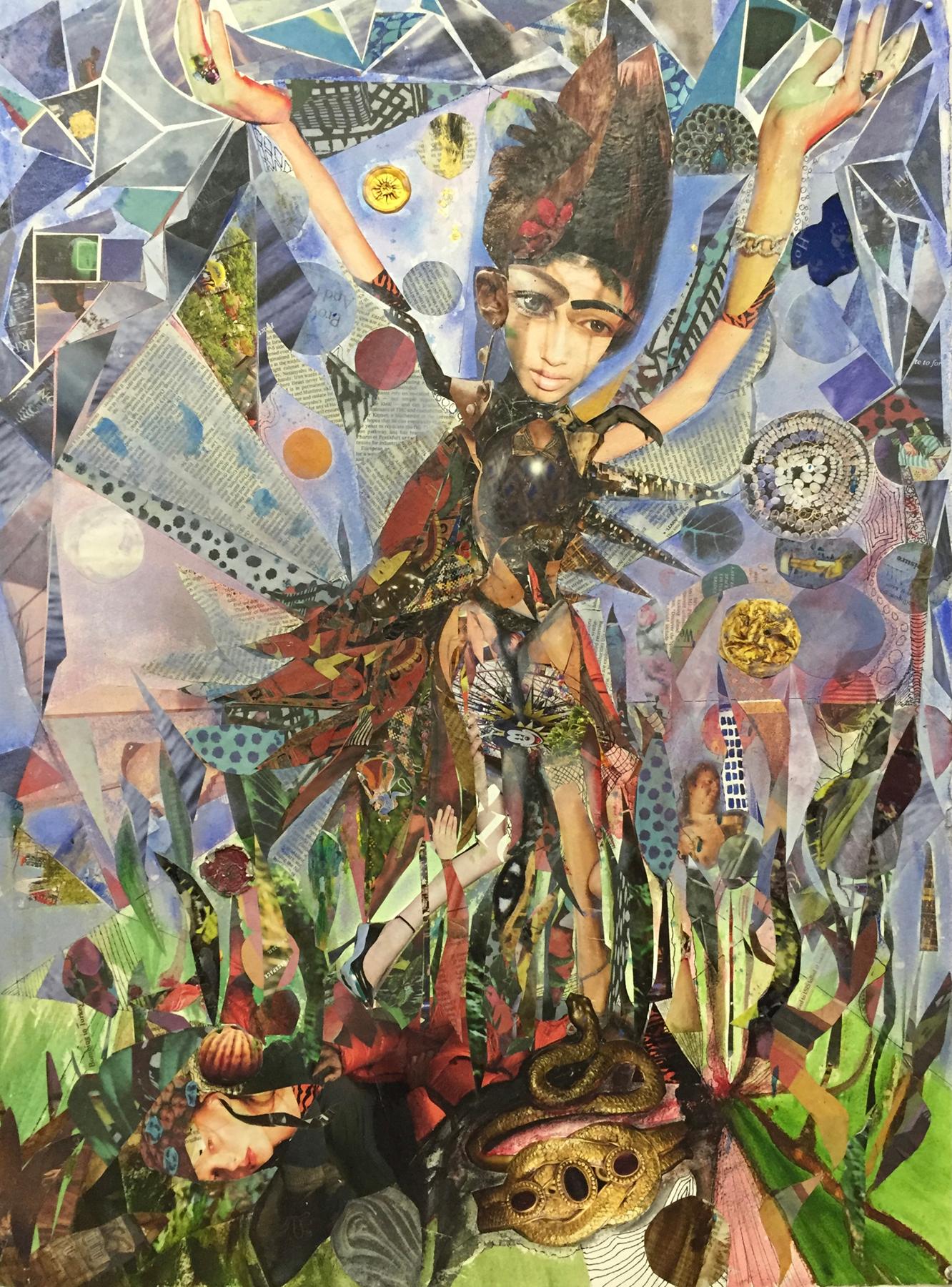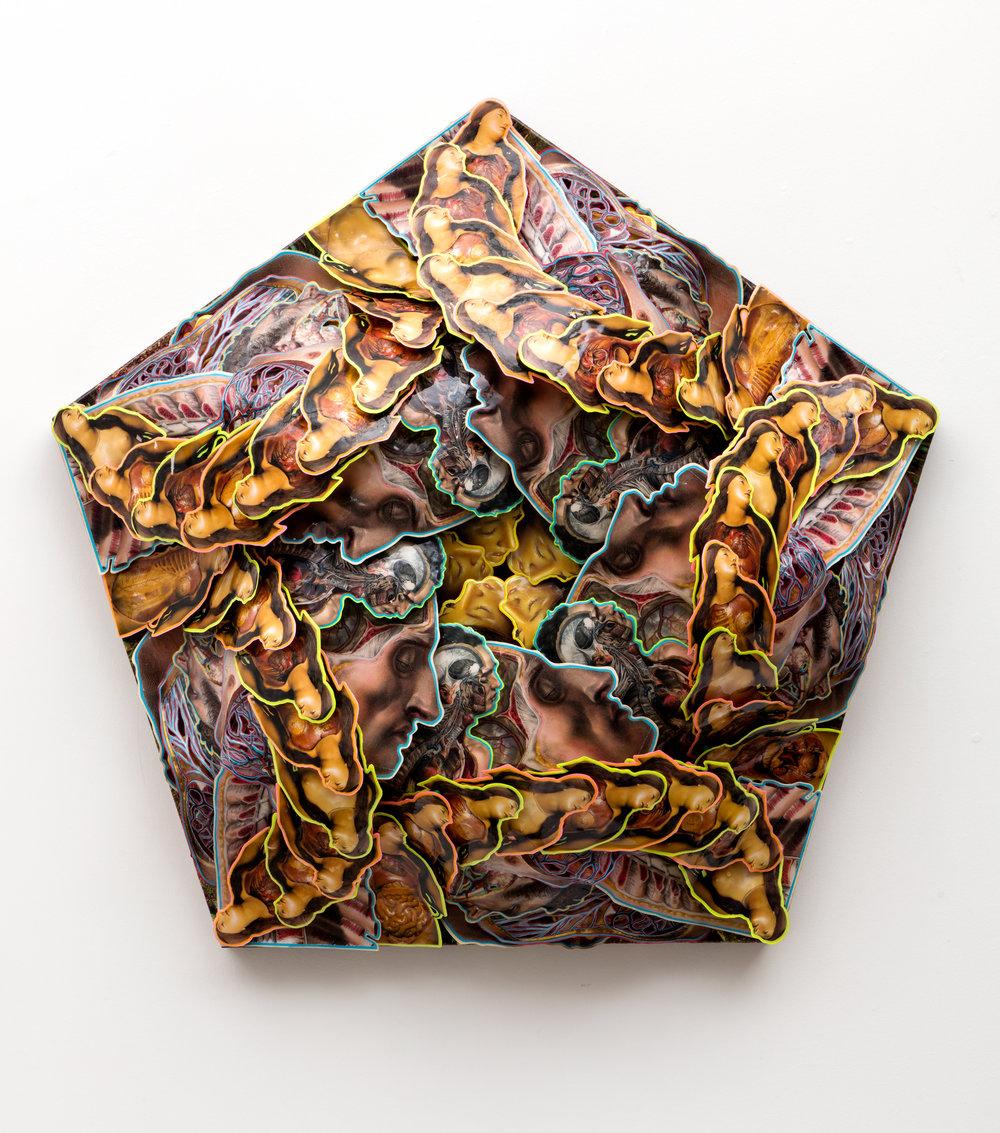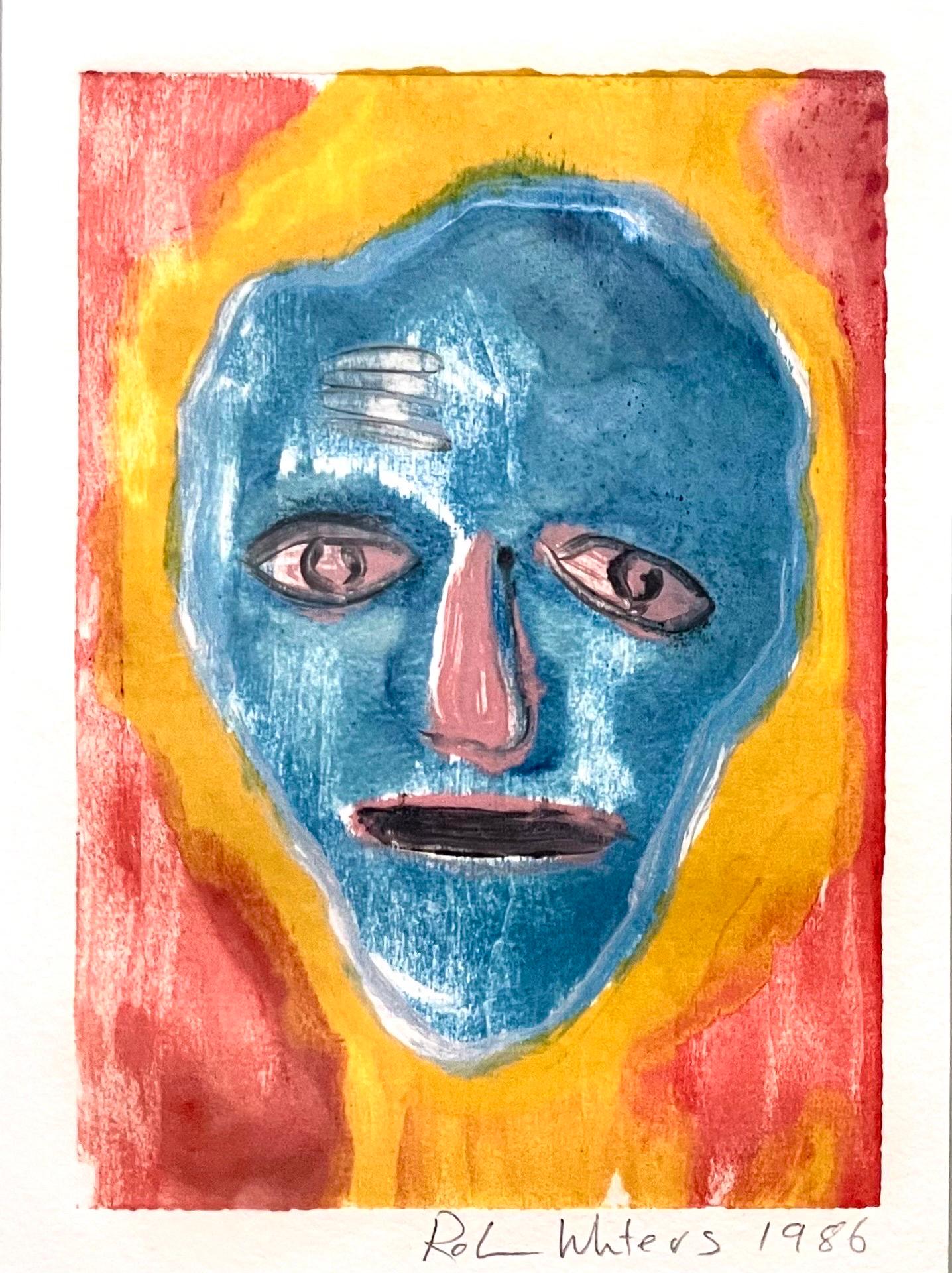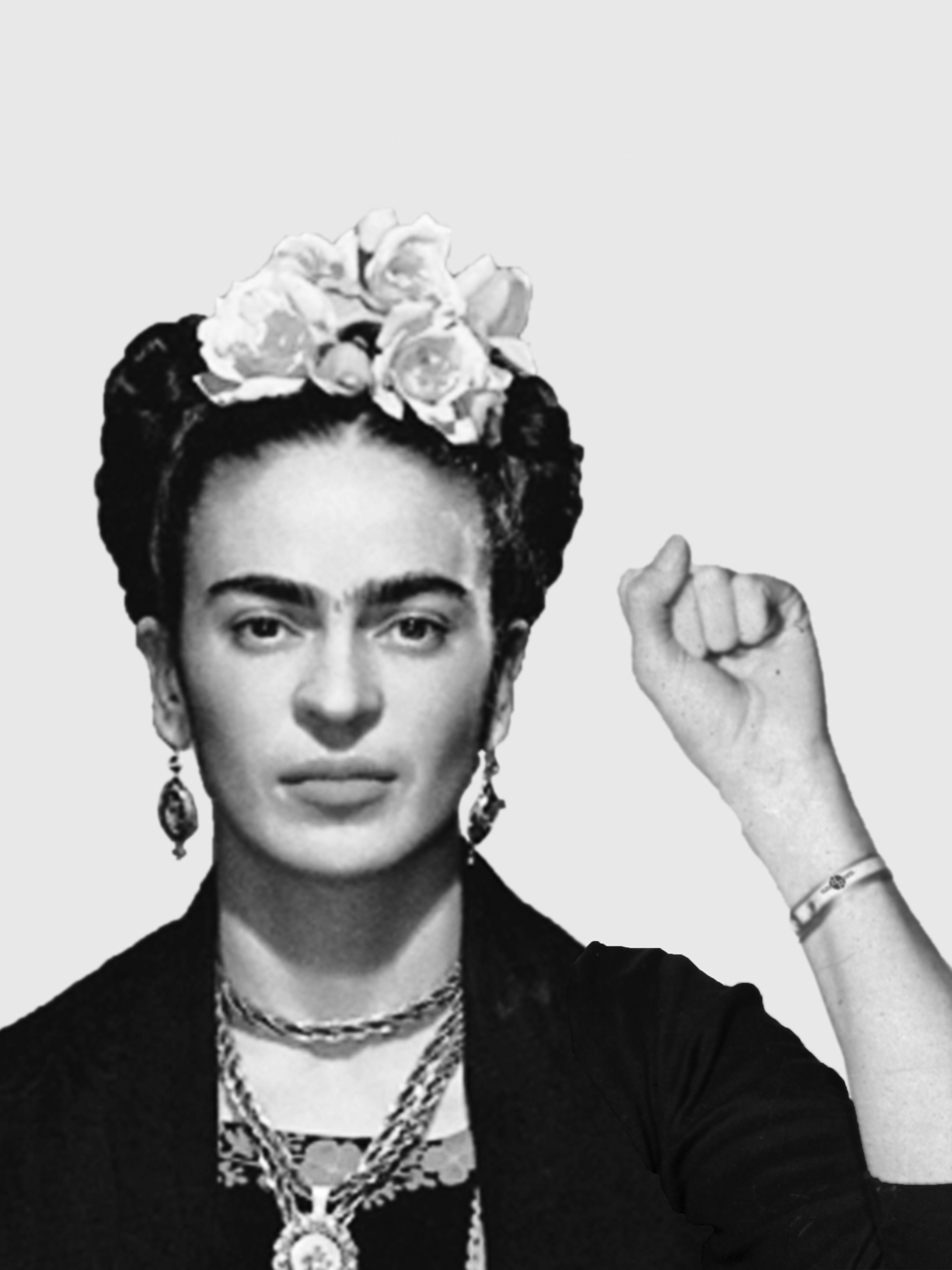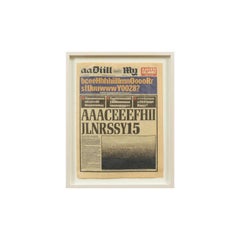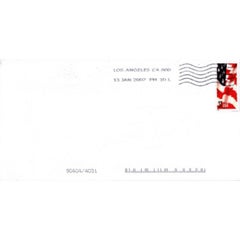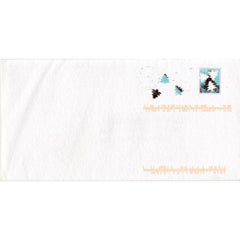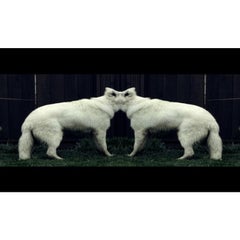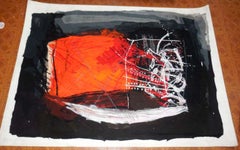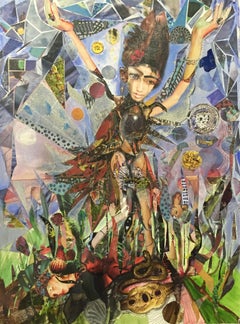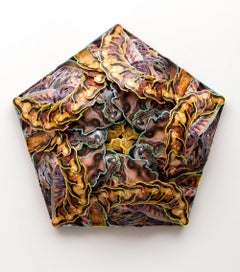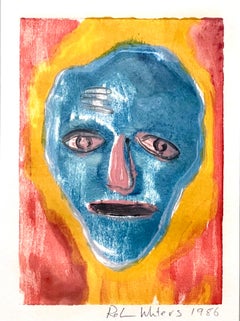Items Similar to Stormtrooper, Stamps on Envelope, 2019
Want more images or videos?
Request additional images or videos from the seller
1 of 2
Kim RuggStormtrooper, Stamps on Envelope, 20192019
2019
About the Item
Stormtrooper, Stamps on Envelope, 2019
Additional information:
Medium: Stamps on envelope
Dimensions: 4 3/10 × 8 7/10 in (11 × 22 cm)
Rugg is renowned for her meticulous and labor-intensive work which involves deconstructing and slicing an object into minute shards to then re-organize and reconstruct it according to arbitrary codes. The original meaning is removed to reveal new ones, and to corrupt or destroy the object’s function. This act of mischievous “sabotage” is applied to ephemeral and iconic objects such as newspapers, comic books, product boxes, sweaters, and stamps, and more recently to larger formats such as wallpaper and furniture – and, by doing so, she turns a neutral vehicle for a message into an object to be considered.
By giving value to something which would normally be disposed of, Rugg transgresses conventional systems by obliterating what is conceived to be the important element, “the content”, and retaining everything else, the material, the shapes, the typography, the color palettes, and the layout. Through these works, she continues her investigation into the relationship between images and their signifier. She questions the way in which the information we process daily is preconceived and prompts the viewer to consider the familiar from an entirely new perspective.
“Some people like taking their time," says Kim Rugg, whose artistic achievements are measured in millimeters, spent X-ACTO blades and picas. We spent the afternoon with Rugg in her London home and studio talking about her work re-imagining newspapers, comics, stamps, and cereal boxes using their existing form while rearranging their content. Kim finds inspiration from the mundane and common objects around us. Her wicked knife skills and tenacious attention to detail have create a body of work that is as impressive as it is curious.
Matter is neither created nor destroyed in Kim Rugg's work, but surgically, strategically repurposed. Rugg reconfigures familiar printed materials: here newspapers, magazines, and maps; previously also postage stamps, comic books and cereal boxes. By altering their forms and tweaking or altogether eliminating their legibility, she slams on the visual brakes, forcing a closer, slower inspection of objects we typically look through rather than at. The raw materials of her enterprise give up their transparency and functionality as information delivery systems to become instead sculptural interpretations of those same systems. They sacrifice one type of authority but assume another.
Rugg received her MFA in Sculpture from the Royal College of Art (London). Her work can be seen in the permanent collections of the National Gallery of Art (D.C.) and the Frederick R. Weisman Foundation (CA), the Museum of Contemporary Art, San Diego (CA), Honolulu Museum of Art, the Norton Museum (FL), and the Museum of Fine Arts Houston (TX) among others. She has been included in exhibitions at the San Jose Institute of Contemporary Art (CA), Elizabeth Foundation for the Arts (NY), Galerie Schmidt Maczollek (Cologne), and Nettie Horn Gallery (Manchester), P.P.O.W. Gallery (NYC), and was the recipient of the Thames and Hudson Prize from the Royal College of Art Society in 2004. She lives and works in London (UK).
- Creator:Kim Rugg (1963, Canadian)
- Creation Year:2019
- Dimensions:Height: 4.3 in (10.93 cm)Width: 8.7 in (22.1 cm)Depth: 1 in (2.54 cm)
- Period:
- Condition:
- Gallery Location:Orange, CA
- Reference Number:1stDibs: LU2793215532982
About the Seller
No Reviews Yet
Recognized Seller
These prestigious sellers are industry leaders and represent the highest echelon for item quality and design.
Established in 1984
1stDibs seller since 2024
- ShippingRetrieving quote...Shipping from: Orange, CA
- Return Policy
Authenticity Guarantee
In the unlikely event there’s an issue with an item’s authenticity, contact us within 1 year for a full refund. DetailsMoney-Back Guarantee
If your item is not as described, is damaged in transit, or does not arrive, contact us within 7 days for a full refund. Details24-Hour Cancellation
You have a 24-hour grace period in which to reconsider your purchase, with no questions asked.Vetted Professional Sellers
Our world-class sellers must adhere to strict standards for service and quality, maintaining the integrity of our listings.Price-Match Guarantee
If you find that a seller listed the same item for a lower price elsewhere, we’ll match it.Trusted Global Delivery
Our best-in-class carrier network provides specialized shipping options worldwide, including custom delivery.More From This Seller
View AllBad Boy Newsprint, 2007
By Kim Rugg
Located in Orange, CA
Bad Boy Newsprint, 2007
Additional information:
Medium: Newsprint (Daily mail)
Dimensions: 15 1/2 × 12 in (39.4 × 30.2 cm)
Rugg is renowned for her meticulous and labor-intensive w...
Category
21st Century and Contemporary Mixed Media
Materials
Newsprint
Long Stars, Reconfigured Postage Stamp and Envelope, 2006
By Kim Rugg
Located in Orange, CA
Long Stars, Reconfigured Postage Stamp and Envelope, 2006
Additional information:
Medium: Reconfigured postage stamp and envelope
Dimensions: 4 × 6 in (10.2 × 15.2 cm)
Rugg is reno...
Category
21st Century and Contemporary Mixed Media
Christmas Trees, Reconfigured Postage Stamp and Envelope, 2007
By Kim Rugg
Located in Orange, CA
Christmas Trees, Reconfigured Postage Stamp and Envelope, 2007
Additional information:
Medium: Reconfigured postage stamp and envelope
Dimensions: 4 × 6 in (10.2 × 15.2 cm)
Rugg is...
Category
21st Century and Contemporary Mixed Media
Grayout, Animation, 2013
Located in Orange, CA
Grayout, Animation, 2013
Additional information:
Medium: Video/Film/Animation
Duration: 0 hours 10 mins 0 secs
Editions 2-4 of 10
Heidi Schwegler explores a wide range of materials...
Category
21st Century and Contemporary Mixed Media
Materials
Video
Pinnocchio, Drawing, Collage or other Work on Paper, 2007
By Kim Rugg
Located in Orange, CA
Pinnocchio, Drawing, Collage or other Work on Paper, 2007
Additional information:
Medium: Drawing, Collage or other Work on Paper
Reconfigured postage stamp and envelope
Dimensions:...
Category
21st Century and Contemporary Mixed Media
Materials
Paper
November 21st #2, Reconfigured Newsprint, 2012
By Kim Rugg
Located in Orange, CA
November 21st #2, Reconfigured Newsprint, 2012
Additional information:
Medium: Reconfigured Newsprint
Dimensions: 24 × 14 1/2 in (61 × 36.8 cm)
Rugg is renowned for her meticulous ...
Category
21st Century and Contemporary Mixed Media
You May Also Like
Stendhal #2 Soft Tapestry wall hanging
By Calman Shemi
Located in Surfside, FL
this is a bright vibrant abstract wall hanging tapestry by Calman Shemi. I believe the material is wool with a linen backing but i am not positive. it can also be used as a floor rug.
Calman Shemi, sculptor and painter, was born in Argentina in 1939. A graduate of the School of Sculpture and Ceramics in Mendoza, he studied under the Italian-Argentinean sculptor Libero Badii whom he credits with putting him on the right path. “He taught me principals, not only related to sculpture, but human and philosophic principals. Shemi also carefully studied the work of such masters as Picasso, Caravaggio, Frank Stella and Matisse. “From each one of these great artists I learned something from observing them,” he says.
In 1961, at the age of 20, Shemi immigrated to Israel and joined Kibbutz Carmia of which he was a member for twenty years. There he worked in agriculture and also as a sculptor working with wood and clay. Several of his large-scale fiberglass and polyester projects are situated in public buildings. He was a student of German-Israeli sculptor Rudi Lehmann, a pioneer of the artistic movement known as “Canaanism.”
Canaanite art was an effort to create a direct relationship with the land, bypassing historic Jewish connotations—hence the land’s primordial name is used. Canaanite works, with an emphasis on the inter-action of simple shapes, bear a deliberate resemblance to the sculpture and ritual art of early civilizations of the Middle East prior to Judaism, always with an eye to the fusion of man and the land itself.
Though sculpture dominated his early years as an artist, in the mid ’70s Shemi developed the idea of the “soft painting” medium. Beginning with a color drawing done to scale, Shemi layers onto the drawing irregularly shaped pieces of variously textured and colored fabrics. Using a threadless 9,000-needle sewing machine, the fabrics are meshed to one another and to the background, resulting in vibrant carpet...
Category
1980s Abstract Expressionist Mixed Media
Materials
Mixed Media
Denise Jones Adler, Goddesses Just Want to Have Fun, 2016, Mixed Media, Mystical
Located in Darien, CT
Denise Jones Adler's work is both personal and archetypical and seeks to memorialize a moment in time, the fragile nature of life, and the emotional impact of the past on the present...
Category
2010s Symbolist Portrait Paintings
Materials
Mixed Media, Archival Paper
"The Cleaving" Contemporary Psychedelic Visualization of the Book of Genesis
Located in Houston, TX
Contemporary psychedelic visualization of the Biblical book of Genesis by Houston, TX artist Patrick Turk. This piece was part of a show that Turk organiz...
Category
2010s Contemporary Mixed Media
Materials
Mixed Media, Acrylic, Panel
Conceptual Pop Art Color Oil Monotype Painting Abstract Figure Robin Winters
By Robin Winters
Located in Surfside, FL
Robin Winters (American, born 1950),
Untitled (Red Face) from "Cherry Block Series" 1986, monotype, pencil signed and dated lower right, plate: 6"h x 8.5"w, overall (with frame): 22.25"h x 18.25"w. Provenance: Property from a Private Collection, San Francisco.
Winters was invited to make monotypes at Experimental Workshop in San Francisco, (they printed Richard Bosman, Sam Francis, Claire Falkenstein, Deborah Oropallo and Kenneth Noland and many more greats). Winters chose to paint on wood blocks rather than the more usual metal plates in order to capture the organic quality of the natural material. He exploited a salient characteristic of the monoprint in Ghost Story by adding new painted elements onto the increasingly faint ghost images that result from successive impressions from a single block. In so doing he achieved the effect of transparent layers of color and shadow imagery. Winters's brightly-colored monotypes portray an array of figures and landscapes (and an occasional still-life) that, although can be seen in the context of a general trend away from abstraction that has marked the 1980s, defy strict stylistic categorization. They are neither realistic nor abstract, psychological self-examinations nor narrative fictions, but they contain elements of all of these approaches. Like Jonathan Borofsky, Winters derives much of his subject matter from dreams, believing that through his private fears and obsessions he can touch similar emotions in others. Although at first glance Winters's images look as if they could have been made by a child, closer attention reveals sly art historical references to Jackson Pollock and Pattern Painting (the drip and splatter backgrounds), Mark Rothko (the three-part horizontal compositions) and Minimalism (the gridded Cherry Block Series: Bread Beat).
Robin Winters (born 1950 in Benicia, California) is an American conceptual, multi-disciplinary, artist and teacher based in New York. Winters is known for creating solo exhibitions containing an interactive durational performance component to his installations, sometimes lasting up to two months. Winters first emerged in the burgeoning Soho NYC art scene of the 1970s. An early practitioner of the Relational Aesthetics (social interaction as an art medium) Winters also created in works through sculpture, installation, performance, painting, drawing and prints. His art maintains a whimsical spirit, and he often returns to ongoing themes involving faces, boats, cars, bottles, hats and jesters or fools. Winters has incorporated such devices as blind dates, double dates, dinners, fortune telling, and free consultation in his performances. Throughout his career he has engaged in a wide variety of media, such as performance art, film, video, writing prose and poetry, photography, installation art, printmaking, drawing, painting, ceramic sculpture, bronze sculpture, and glassblowing.
Winters was born in Benicia, California in 1950 to lawyer parents. As a child his hobby was collecting glass bottles found on the beach and under old buildings, which would later influence him as an artist. In 1968, Winters had his first durational performance, entitled Norman Thomas Travelling Museum. The artist drove a Volkswagen bus decorated in collage, many of the images relating to current events and politics. Inside was what the artist described as a “reliquary” containing many objects, including a bottle collection. Winters took the van to shopping centers and even as far as Mexico. That same year, Winters opted not to register for the military draft. Although he was deemed fit to serve, Winters refused. In 1975 the resulting legal proceedings finally came to a close after it was proven that the artist had been harassed by the local draft board. In his teens and early twenties, Winters became acquainted with several local artists who helped shape his aesthetic, most notably Manuel Neri and Robert Arneson. By the early 1970s, Winters was studying at the San Francisco Art Institute (SFAI) and had relocated to San Francisco. At this time Winters became friends with the Bay Area conceptual artists Terry Fox and Howard Fried, and participated in several of Fried's performance works. In 1972 Winters was accepted into the Whitney Independent Study Program in New York City. After coming to New York City, Winters helped support himself by working for various artists, among them the performance artist Joan Jonas and sculptor Donald Judd. In 1974, Winters performed The Secret Life of Bob-E or Bob-E Behind the Veil eight hours a day, five days a week for a month in his studio apartment. Behind a one-way mirror the audience could watch Winters play the character of Bob-E, whose goal was to make a monument for everyone in the world in the form of blue and yellow rubber top hats. By the end of the month the artist had constructed 262 hats. The following year, Winters was invited to take part in the Whitney Museum's 1975 Biennial Exhibition. Entitled W.B. Bearman Bags a Job or Diary of a Dreamer. Winters was traveling in 1975 and 1976, spending time in North Africa and in Europe. At a time when most young American artists were unaware of their European counterparts, Winters met and was influenced by such artists as Sigmar Polke and Marcel Broodthaers (with whom Winters worked on an installation) and also had a one-person exhibition, at the Konrad Fischer Gallery in Dusseldorf. Returning to New York in 1976, Winters teamed up with a group of artists to form Collaborative Projects (Colab), a rather anarchistic organization dedicated to artistic collaboration and the creation of art that questioned social values.. Also in 1976, Winters formed the partnership “X&Y” with fellow artist Coleen Fitzgibbon that would last two years. Together they performed a series of shows in the Netherlands, most notably a show entitled Take the Money and Run. Performed at De Appel in Amsterdam, the show involved the artists robbing their audience. The following day the audience was given an apology, as well as the opportunity to retrieve any valuables and participate in a lottery to win the artists’ services. They also made a Super 8 film in NY called Rich-Poor, in which they asked people on the streets their thoughts on the rich and poor.
In 1980 Winters participated in The Real Estate Show and in Absurdities at ABC No Rio. That same year he and artists Peter Fend, Coleen Fitzgibbon, Peter Nadin, Jenny Holzer, and Richard Prince also formed The Offices of Fend, Fitzgibbon, Holzer, Nadin, Prince & Winters. This short-lived collective was based out of an office on lower Broadway and offered “Practical Esthetic Services Adaptable to Client Situation”, as stated on their business card. Their goal was to offer their art as “socially helpful work for hire”. In June of that year Winters participated in The Times Square Show, Colab's most well-known exhibition. The month-long show took place in a four floor building on West 41st Street and was densely packed with art. To cap off a busy year, Winters also became one of the first artists to join the Mary Boone Gallery, showing a successful solo exhibition in 1981. His work was shown in the New York/New Wave show in 1981 at MoMA PS1 along with Jean-Michel Basquiat, Roberta Bayley, William S. Burroughs, David Byrne, Sarah Charlesworth, Larry Clark, Crash (John Matos), Ronnie Cutrone, Brian Eno, Peter Fend, Nan Goldin, Keith Haring, Ray Johnson, Joseph Kosuth, Marcus Leatherdale, Christopher Makos, Robert Mapplethorpe, Elaine Mayes, Frank Moore, Kenny Scharf and others. In 1982, Winters had his first solo exhibition in Los Angeles at the Richard Kuhlenschmidt Gallery. At the Mo David Gallery in 1984, Winters created an installation piece that consisted of a floor of plaster tiles. Underneath each tile, hidden from view, was a drawing. He designed the stage sets for the musician Nico, and assisted French artist Orlan, American artist Stuart Sherman, and American poet Gregory Corso. Two years later Winters was invited to take part in Chambres d’Amis (In Ghent there is Always a Free Room for Albrecht Durer) in Ghent, Belgium. In it, 51 artists created installations in 50 different sites, mostly private homes. Winters chose the home of a local art historian. The artist made 90 drawings based on images found in the large collection of art books in the home's library. He made two copies of each drawing and placed the originals in the books themselves. One set of copies was exhibited in the sponsoring museum, Museum van Hedendaagse, as "The Ghent Drawings". The drawings were also on display at Winters’ solo exhibition at Luhring Augustine & Hodes Gallery in New York City in 1987.
In 1986, Winters had a solo exhibition at Maurice Keitelman Gallery in Brussels, Belgium, and the following year a solo exhibition at the Centre Régional d'Art Contemporain Midi-Pyrénées in Toulouse, France. Also in 1986, Winters' Playroom was held at the Institute for Contemporary Art in Boston, Massachusetts. The exhibition was part of Think Tank, a retrospective of Winters' work which traveled to the Stedelijk Museum in the Netherlands, the Centre Regional d’Art Contemporain in France, and the Contemporary Arts Center in Ohio. Winters spent a month in 1989 working with students at the San Francisco Art Institute. Never having worked with ceramics, he spent the month making numerous ceramic pieces, which were then shown in the aptly named One Month in San Francisco. Other components of the piece included Winters’ childhood bottle collection and a video showing each piece in the show filmed briefly next to a ruler.[ Also that year, Robin served as a visiting artist at the Pilchuck Glass School, where he met artist John Drury, who was then working as the school's artist liaison.
In the summer of 1990, Winters interviewed fellow artist Kiki Smith for her eponymous book, which was published later that year. That same year (1990), Winters was invited by the Val Saint Lambert glass factory in Belgium to create glassworks in their facility. Winters, artists John Drury and Tracy Glover...
Category
1980s Pop Art Figurative Paintings
Materials
Monoprint, Monotype
Cigar And Cordial Painting, Mixed Media on Canvas
By Tony Rubino
Located in Yardley, PA
For the man-cave experience. Cigar And Cordial Painting Foodie Cigar Lover Smoking Smoker. Are you a cigar fan who loves to smoke cigars? These make perfect gift ideas for friends and family who can’t get enough foodie finer things and liquor and brandy. A cool, gift for a man or woman who is a cognac lover or, brandy lover, and likes to make a statement about, luxury, birthday, Christmas, Memes, funny pictures or serious fine art. This artistic nostalgia, Retro painting...
Category
2010s Impressionist Mixed Media
Materials
Mixed Media
Frida Kahlo Mug Shot Mugshot, Mixed Media on Canvas
By Tony Rubino
Located in Yardley, PA
Frida Kahlo de Rivera was a Mexican painter, who mostly painted self-portraits. Inspired by Mexican popular culture, she employed a naïve folk art style to explore questions of identity, postcolonialism, gender, class, and race in Mexican society. Are you a Frida Kahlo fan who loves Mexico? These make perfect gift ideas for friends and family who can’t get enough Mexican art and modern art. A different, cool, gift for a man or woman who is a strong woman lover or, equality lover, and likes to make an independent statement about, painting, painter, artist, birthday, Christmas, Memes, funny pictures or serious fine art. Shop this bold, bright, colorful, black and white awesome design. This independent artistic nostalgia, Retro painting men and women makes beautiful original, pop art Tee shirts, Tees, posters and prints. From Tony Rubino classic fashion gift...
Category
21st Century and Contemporary Contemporary Mixed Media
Materials
Mixed Media
Recently Viewed
View AllMore Ways To Browse
Us Stamps
Postage Stamp Art
Postage Stamp Collections
Used Furniture Hudson Ny
3d Wallpaper
Circus Circus
Picasso 1969
Focus Mirror
Serigraph Prints Signed
Green Field Painting
Painting And Happiness
Paris Club
Dior Street
Edition Modern Los Angeles
Heart Photograph Frame
Recently Viewed
The Forum
Country House Paintings
